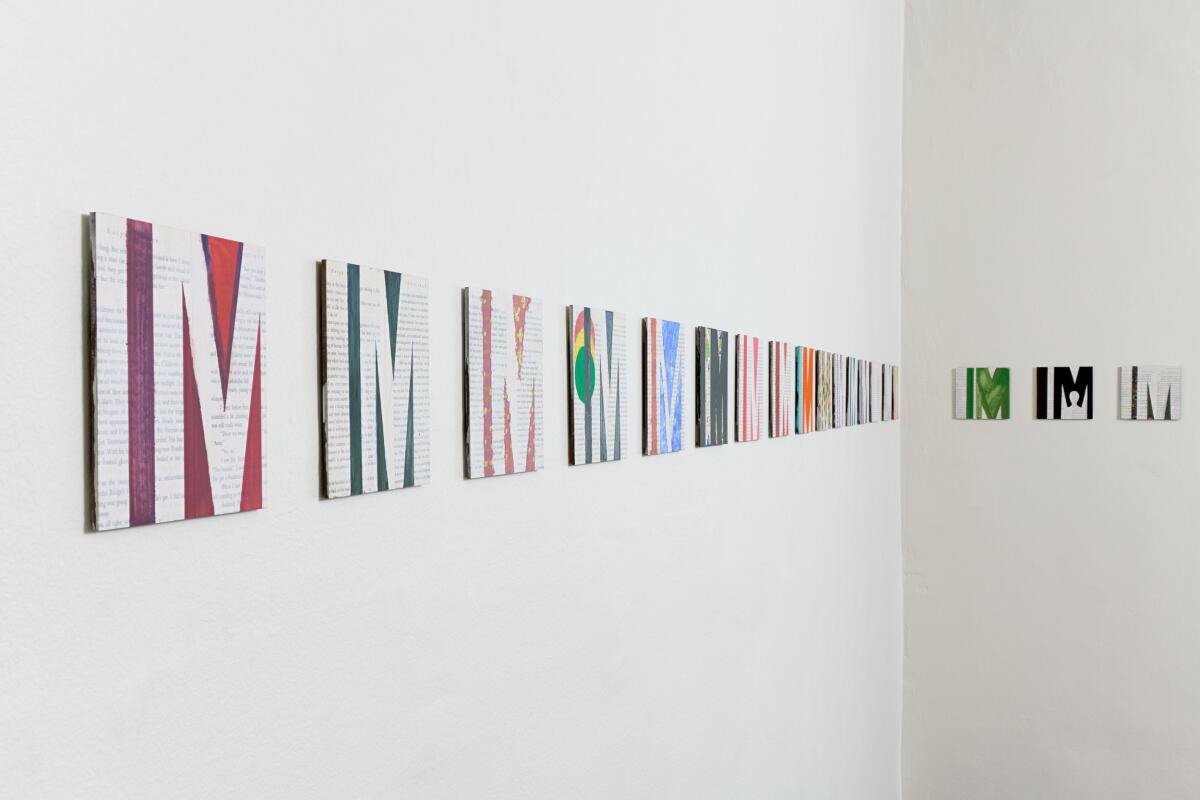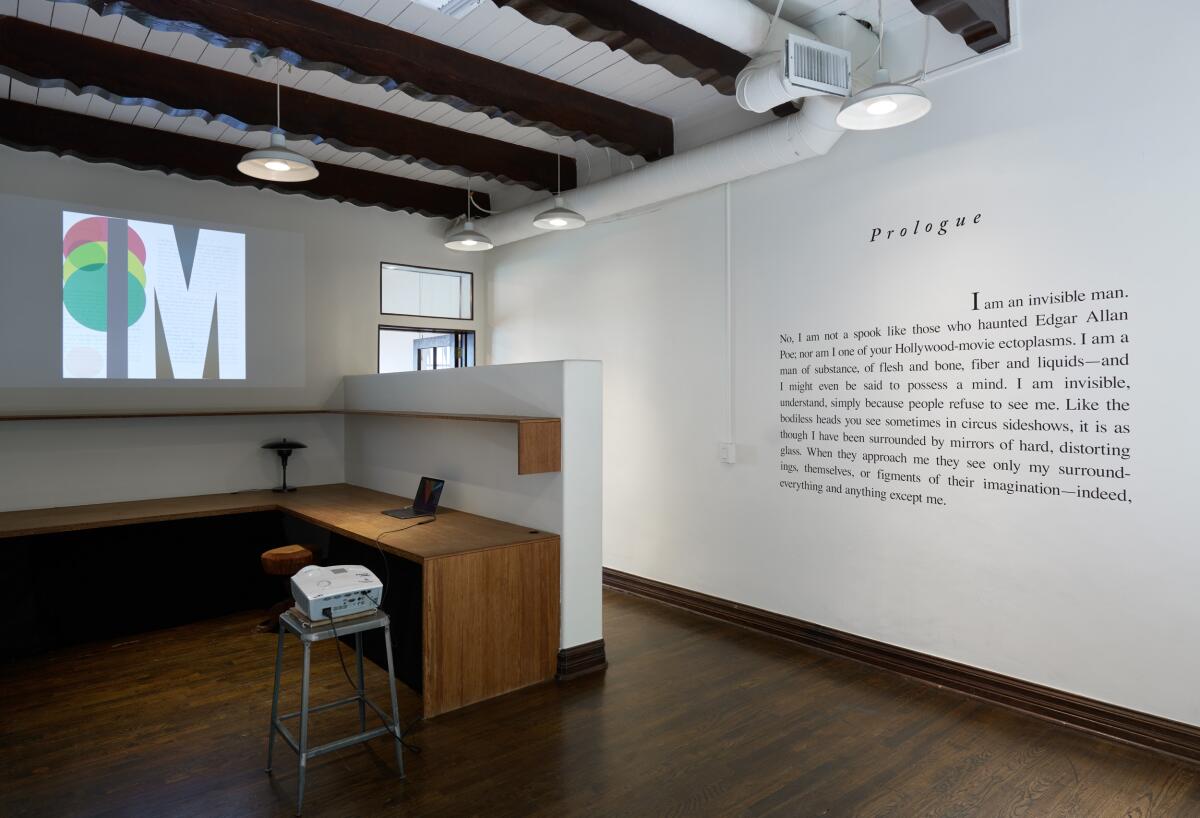Studio K.O.S., short for Kids of Survival, brings the art of social justice to L.A.

- Share via
Amid renewed hand-wringing in the art world over what it means to be an artist and also an advocate, and whether it’s possible to be both at once, Studio K.O.S., an art collective founded by artist Tim Rollins with South Bronx middle school students in 1982, has mounted its first Los Angeles exhibition.
Originally called Art and Knowledge, K.O.S. stands for Kids of Survival, and it has grown from an inner-city arts program to an evolving arts collective with an international imprint. Each canvas in its L.A. show, “Invisible Man” at the gallery O-Town House, is made up of actual pages from a copy of the eponymous book — a standard feature across the majority of K.O.S.’ work, and a tricky one.
Are the books destroyed or reborn? One definition of destroying a book would be to make it unreadable, yet the paintings are visceral evidence of a physical and energetic engagement with the text through the oral readings, music and improvisational image generation that occurs in the workshop, including a process called “jammin” in which the artists draw or paint while another reads aloud. When they were asked via text message what the workshop experience was like for them, student Anna Jones texted back, “The room felt holy.”
“Our conversations created an electricity and synergy that fueled my mind around the intersections of literature, social justice and visual art. ... We worked individually, yet it felt communal.”
Chopped and screwed and reassembled, the text folds out into new forms of legibility, freeing it from the technology of the book.
Although the study images were small, finished paintings from the “Invisible Man” series were mounted on 36-by-36-inch canvases and seemingly attacked on all sides by three triangles and one rectangle that form the letters I-M in negative space. The giant I-M of the paintings alternatively appear as Modernist abstraction or graphic typography, becoming like Rubin’s vase or a Rorschach test of aesthetic sympathies. As when trying too hard to look at a 3D eye image, commanding it to be one thing or another, relaxing the eye allows it to be both. This tension becomes the backdrop to studio-generated large paintings, which have the look of a single author but are the result of many hands.

The knifelike triangle coming down from the top baseline of the “M” graphic is reminiscent of the red triangle in El Lissitzky’s 1919 Soviet propaganda poster “Beat the Whites With the Red Wedge,” a lithograph of a sharp red isosceles symbolizing the Bolsheviks of the 1917 Russian Revolution, piercing a white circle symbolizing the anti-communist party. Like the Constructivists, earlier “Invisible Man” series adhered to a strict palette — though red is conspicuously absent. Plangent blue dominates against the backdrop of black-and-white text. Black, white and blue might be a poetic coda for what we’ve been through. Say “black, white and blue” enough times and it sounds like an elegy for America, sung only through color.
For current show at O-Town House, a gallery run by Scott Cameron Weaver out of the historical Granada Buildings in MacArthur Park, students from the Windward School, a private college-prep school in Mar Vista, and Ryman Arts, an extracurricular nonprofit art program made up of students from different schools, got together for a workshop facilitated by artists and original K.O.S. members Angel Abreu and Rick Savinon. Putting together workshops for different groups seems key to keeping the energy and spirit of the K.O.S. process alive.
Abreu joined K.O.S. in 1986 at the age of 12. Now, along with other original members including Savinon, Jorge Abreu and Robert Branch, he helms the ongoing evolution of the group — which is expanding into digital and video work, also on view at O-Town House — in addition to his own art practice and a teaching post at the School of Visual Arts in New York. K.O.S. started with middle school students in the Bronx but over the years has collaborated with high school and graduate students, usually from a single school or organization. The mixing of students from different groups in a single workshop “was new for this particular project, and it opened up our eyes as to what the possibilities could be,” says Angel Abreu. The shift in scale between “Invisible Man” and the work produced in previous workshops based on the same text reflects the adaptive nature of K.O.S.’ group process.
The work on view at O-Town House is part of a larger, ongoing series generated from various workshops around the country that will culminate in an exhibition at the Massachusetts Museum of Contemporary Art once the series reaches 1,369 — the number of lightbulbs the narrator of “Invisible Man” has wired to the ceiling of his basement hovel and powers with electricity illegally siphoned from the power company. There are 47 of them on display at O-Town House, generated from a one-day workshop hosted by the gallery, growing the larger work along the way. “We’re at 350, close to 400 right now,” Savinon says. “That’s a guesstimate.” The smaller scale of the newer paintings allows the workshop method to become leaner, mobile and draw more participants into the studio.
Since the death of artist and K.O.S. founder Tim Rollins in 2017, the group had to adapt not only to the COVID-19 pandemic but also the changing nature of how students interact with media. “We’ve come up with new protocols for the workshops that involve digital tools,” Abreu says. “We have one hand extended toward the analog and one toward the digital, and we’re trying to be conduits for both because it’s never been more important to have that tactile relationship with books. We don’t want to lose that, but we also just can’t keep doing the same thing.”
The show consists of many variations on the original I-M graphic, done this time on small 6-by-6-inch Masonite panels and hung in one straight line that forms a ring around the main gallery space. It’s a fitting reentry into this work. When asked what inspired them to use “Invisible Man” for this series, when the group’s source material has ranged from Shakespeare to opera to romantic literature, Savinon explains, “It was George Floyd’s murder. We’ve been playing with this text since the late ’80s, early ’90s. We grew up in poor communities where we saw that time and time again. We always link history with current events, and with George Floyd, it just seemed like this thing that we’ve seen over and over and over. The I-M comes from the word victim. You take away the V, the I, the C, the T … all you have left is the I and the M. I am a person, I am a man, I am someone, I am someone to be listened to.”
The installation of this show, consisting of many small paintings as opposed to fewer larger ones, carries the feel of a chorus, many voices saying “I AM, I AM, I AM,” alternately a chant, a protest, a poem. The collection of individual panels also makes room to showcase the range of individual voices that make up the project as a whole. “One of the biggest messages I took from our analysis ... was the concept of individuality,” said student Selina Yu after the show’s opening. “Everyone is different, from their thought processes to the experiences. I was exploring abstract ways of portraying individuality.”
The work K.O.S. produces, like most art that comes through the MFA-to-gallery-system pipeline, is a studio-based process, characterized by access to physical space that is solely for experimentation and creation of art, and prioritizing the process of making the work over achieving a specific end result. It is the seamless integration of those processes into a model that is both itinerant and collaborative that turns the digestion of source material into a group effort that makes it unique among other efforts to steward the youth into the arts while keeping them separate from the art world. “The social” in contemporary art so often gets ground down to a theme, or a subject — the work is about the lopsidedness of history, it’s about capitalism or the art market or collective labor.
The problem is common: how to frame collective acts — that which we fatuously scoot behind the aegis of the Art of Living — as capital-A Art. How to make community legible as an aesthetic commodity, a thing of optical purchase, available for purchase? The stickiness of these issues is avoided by avoiding the art market, and by extension the art world altogether, but as writer Susan Cahan points out in her catalog essay for the 2009 exhibition “Tim Rollins and K.O.S.: A History” at Skidmore College, “by contrast ... K.O.S. jumped into the market enthusiastically.” Since its first gallery show at Jay Gorney Modern Art in New York in 1986, the work of Studio K.O.S. has been placed in over 120 museums and collections all over the world. (Chase Bank owns one of the works from that show, “Amerika I,” from the series based on Franz Kafka’s unfinished first novel, “Amerika.”) They have participated in a veritable royal flush of international art fairs, including the 1985 and 1991 Whitney Biennial, the 1988 Venice Biennale and documenta 8.
The power and longevity of the group lie in this fusion of aesthetics and social justice, even more rare for its conceptual sophistication and haute stature in the art world. Justice itself is an artistic act, and accessible to everyone. Philosopher and activist Simone Weil, who died in the middle of World War II, articulated the possibility of this fusion when she wrote: “Love for our neighbor, being made of creative attention, is analogous to genius.”
“The ultimate artwork,” Abreu says, “is for those kids to actually forge friendships and figure out ways to relate to each other, maybe beyond the workshop.”
More to Read
The biggest entertainment stories
Get our big stories about Hollywood, film, television, music, arts, culture and more right in your inbox as soon as they publish.
You may occasionally receive promotional content from the Los Angeles Times.










